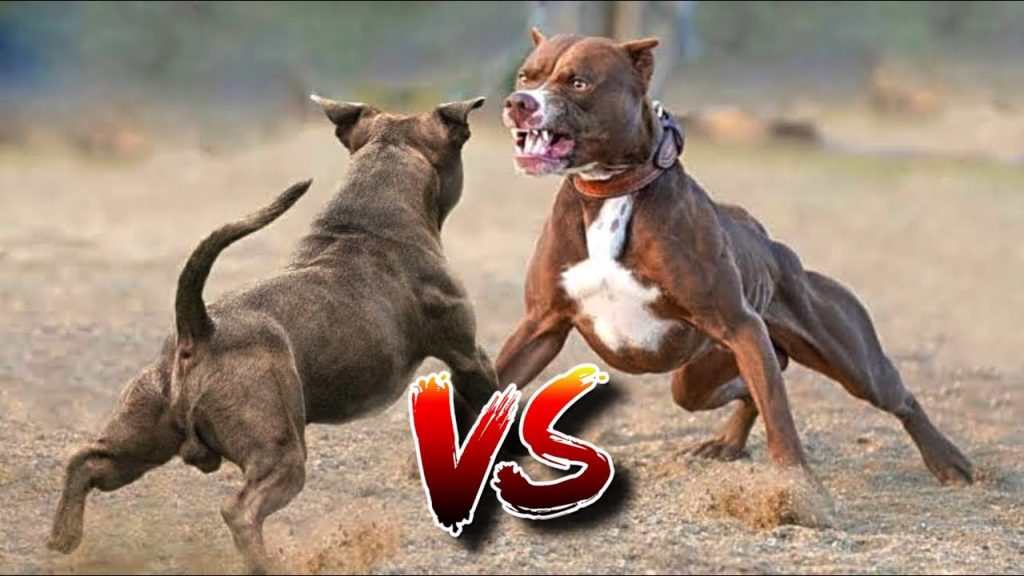
The term fighting dog does not refer to a single breed. Strictly speaking, it is a description that is to be used for dog fights. In these fights, either two dogs compete against each other. Sometimes a bear or a wolf is brought into the ring against the dog.
This is at least the original definition. These dogs were specially bred, trained and ultimately sent into battle for this purpose. This information is also addressed in the FCI breeding standards.
However, it is equally noted that breeding animals that have a tendency to a certain aggression or have become conspicuous accordingly are to be taken out of the breeding. This is to avoid that this genetic information is passed on to the puppies and thus to the posterity.
Now it must be admitted that today most dogs, including those of the breeds mentioned, are no longer bred for fighting purposes. Wolves and bears are no longer available. Fights “dog against dog” are illegal. Unfortunately, they still occur from time to time in shady areas and societies. What seems to be a great fun for people is simply brutal and cruel for animals.
The so-called fighting dogs and their ancestors have also been used as war dogs for centuries. They should be at their master’s side not only as a loyal friend, but also as a backup. Even today, dogs are used by the military for certain tasks.
What makes a fighting dog?
Whether a dog is dangerous, i.e. falls under the concept of a fighting dog, depends on different criteria. Thus, the appearance of the dog is automatically concluded to the dangerousness of the animal. Also different breeds are per se called fighting dogs, which means that they are on the so-called list of dangerous dog breeds.
Thus, dog breeds can also be found on this list, which have attracted attention due to biting attacks in public, either against other dogs or even against people (more about this on listed dogs).
Of course, this does not necessarily mean that this breed has correctly received the classification. Rather, it is a matter of individual animals that have been either badly or incorrectly trained, so that they have given in to their genes and remembered their “old” task – namely, unconditional defense.
There is one more thing to consider in UK: Which dog breed is counted as a fighting dog is decided individually by each federal state. Thus, it may well happen that some dogs are put on the list by some federal states, while others are not. In addition, there are fighting dogs level 0 and level 1 as well as level 2.
- Level 0 = This breed is listed as a fighting dog. Nevertheless, it does not appear in any specially kept list.
- Level 1 = These dog breeds are classified as dangerous. They may be kept exclusively with legitimate interest.
- Level 2 = Level 2 dog breeds may be kept. However, there are requirements that must be met in order to be approved for keeping. Again, it varies from region to region what these requirements are. This can even vary from district to district. It is advisable to keep up to date with the relevant requirements.
The list of dogs probably speaks for itself.
- Alano: level 2 in Bavaria, Brandenburg and North Rhine-Westphalia
- American Bulldog: level 0 in Hesse; level 2 in Bavaria and North Rhine-Westphalia
- American Pitbull Terrier: level 0 in Berlin, Bremen, Hesse, Mecklenburg-Western Pomerania, Rhineland-Palatinate, Saarland, Saxony, Saxony-Anhalt; level 1 in Bavaria, Brandenburg, Hamburg, North Rhine-Westphalia; level 2 in Baden-Württemberg
- American Staffordshire Terrier: level 0 in Berlin, Bremen, Hesse, Mecklenburg-Western Pomerania, Rhineland-Palatinate, Saarland, Saxony, Saxony-Anhalt; level 1 in Bavaria, Brandenburg, Hamburg, North Rhine-Westphalia; level 2 in Baden-Württemberg
- Bangdog: level 1 in Bavaria
- Bullmastif: level 0 in Berlin; level 2 in Baden-Württemberg, Bavaria, Brandenburg, Hamburg, North Rhine-Westphalia
- Bullterrier: level 0 in Berlin, Bremen, Hesse, Mecklenburg-Western Pomerania, Saxony, Saxony-Anhalt; level 1 in Brandenburg, Hamburg, North Rhine-Westphalia; level 2 in Baden-Württemberg, Bavaria
- Cane Corso Italiano: level 2 in Bavaria and Brandenburg
- Dobermann: level 2 in Brandenburg
- Dogo Argentino: level 0 in Berlin and Hesse; level 2 in Baden-Württemberg, Bavaria, Brandenburg, Hamburg, North Rhine-Westphalia
- Dogo Canario: level 2 in Bavaria and Baden-Württemberg
- Dogue de Bordeaux: level 2 in Baden-Württemberg, Bavaria, Brandenburg, Hamburg, North Rhine-Westphalia
- Fila Brasileiro: level 0 in Berlin and Hessen; level 2 in Baden-Württemberg, Bavaria, Brandenburg, Hamburg, North Rhine-Westphalia
- Kangal: level 0 in Hesse; level 2 in Hamburg
- Caucasian Owtscharka: level 0 in Hesse; level 2 in Hamburg
- Mastiff: level 0 in Berlin; level 2 in Baden-Württemberg, Bavaria, Brandenburg, Hamburg, North Rhine-Westphalia
- Mastin Espanol: level 0 in Berlin; level 2 in Baden-Württemberg, Bavaria, Brandenburg, Hamburg, North Rhine-Westphalia
- Mastino Napoletano: level 0 in Berlin; level 2 in Baden-Württemberg, Bavaria, Brandenburg, Hamburg, North Rhine-Westphalia
- Perro de Presa Mallorquín: level 2 in Bavaria and Brandenburg
- Rottweiler: level 0 in Hessen; level 2 in Baden-Württemberg, Bavaria, Brandenburg, Hamburg, North Rhine-Westphalia
- Staffordshire Bullterrier: level 0 in Bremen, Hesse, Mecklenburg-Western Pomerania, Rhineland-Palatinate, Saarland, Saxony-Anhalt; level 1 in Bavaria, Brandenburg, Hamburg, North Rhine-Westphalia; level 2 in Baden-Württemberg
- Tosa Inu: level 0 in Berlin; level 1 in Bavaria and Brandenburg; level 2 in Baden-Wuerttemberg, Hamburg or North Rhine-Westphalia.
Each federal state imposes the requirements to be met on its own. Therefore, it is always important to find out about the regional requirements when changing residence or going on vacation.
What are they like, the fighting dogs?
As we have already noted, not all dogs on the list are also one of the “fighting dog breeds” listed above. Thus, a German shepherd dog can become just as conspicuous. The reason for this can be a wrong education, a failed socialization and the like. By the way, this is also often the reason why one of the list dogs “goes off the rails”. Certainly they have a higher aggression potential than other dog breeds.
Certainly they are also physically well developed for fighting and attacking. However, all people with dog sense know that it is the dog’s upbringing and its bond with man that makes it. Promote only the positive traits. Find a trainer who is knowledgeable in aggression avoidance. No, not every dog needs this specific training.
But it is very reassuring as an owner to know how it goes and how to respond. You may never need this knowledge. But being prepared doesn’t hurt either.
Short portraits of common representatives of the list
The American Pitbull Terrier
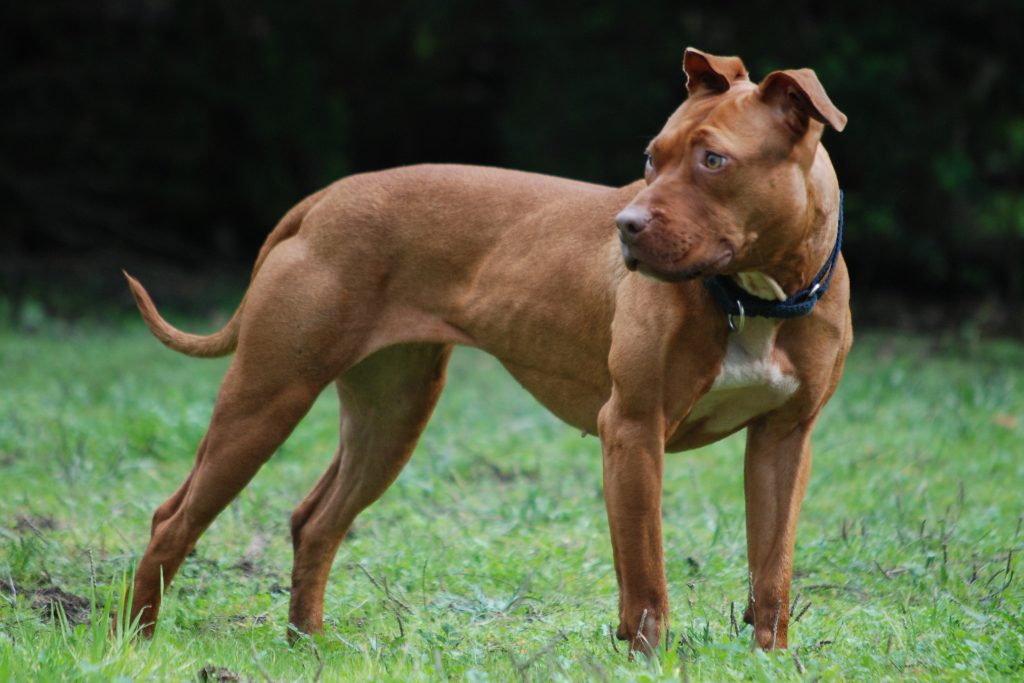
As its name suggests, its country of origin is the USA. The FCI classifies it in group 2. He belongs to the guard dogs and is a medium sized dog. His physique is strong, elegant and compact. He has a short coat, which is allowed in all colors.
The American Pit Bull Terrier has a height of 45 to 55 centimeters with a weight of 20 to 25 kilograms. A lifespan of up to 12 years is common. On if the inclusion on the list suggests the opposite, he is an attentive, faithful, self-confident and also good-natured dog.
Of course, this assumes a serious breeder. The breeders of this dog breed are not organized seriously. In order to keep the American Pitbull Terrier in the best possible condition, it is necessary not only to provide him with sufficient exercise, but also to give him a task that soothes or satisfies his guard instinct.
American Staffordshire Bull Terrier
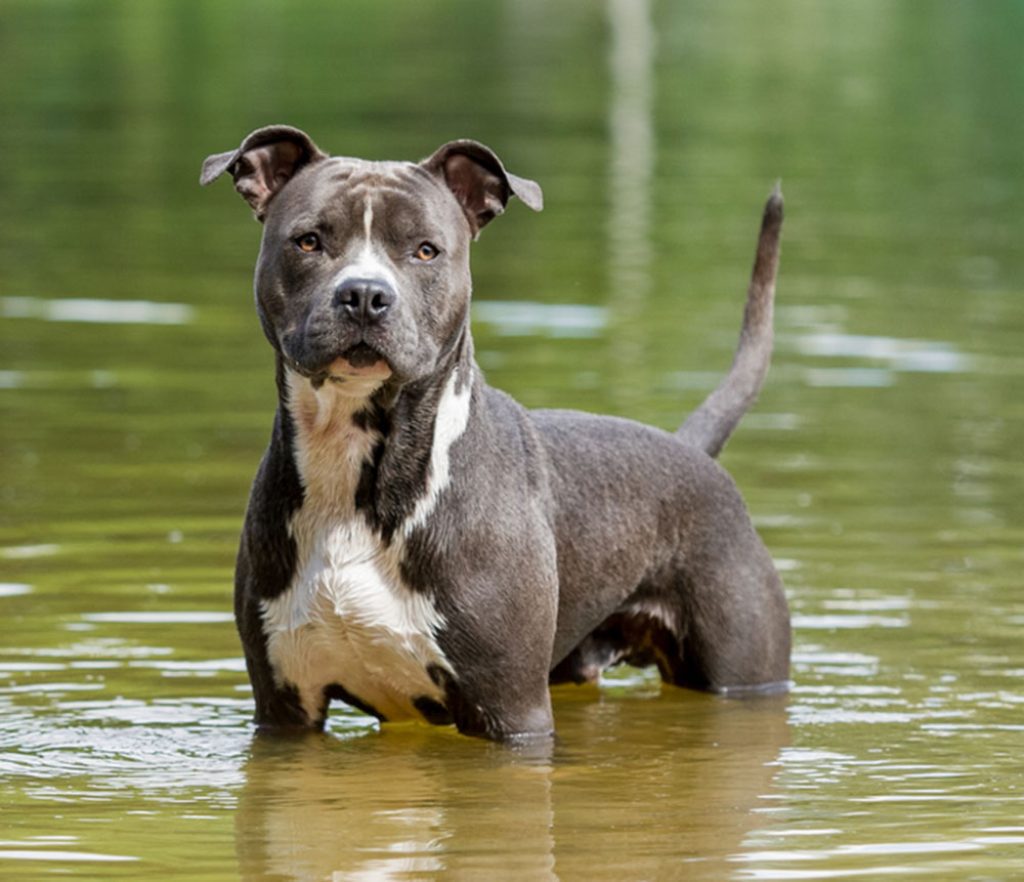
According to the FCI classification, this dog belongs to group 3, to family dogs. It is a medium-sized dog with an average weight of 20 to 30 kilograms and a height at the shoulder of 43 to 48 centimeters. Visually, the American Staffordshire Bull Terrier varies between a clown, due to its face, and an elegangen, compact powerhouse.
Those who choose this dog will find that it keeps you quite busy. This dog is also easy to handle as long as he is given both a task and enough daily activity by his owners. Unfortunately, this dog breed is prone to hip dysplasia as well as elbow dysplasia.
The Bull Terrier
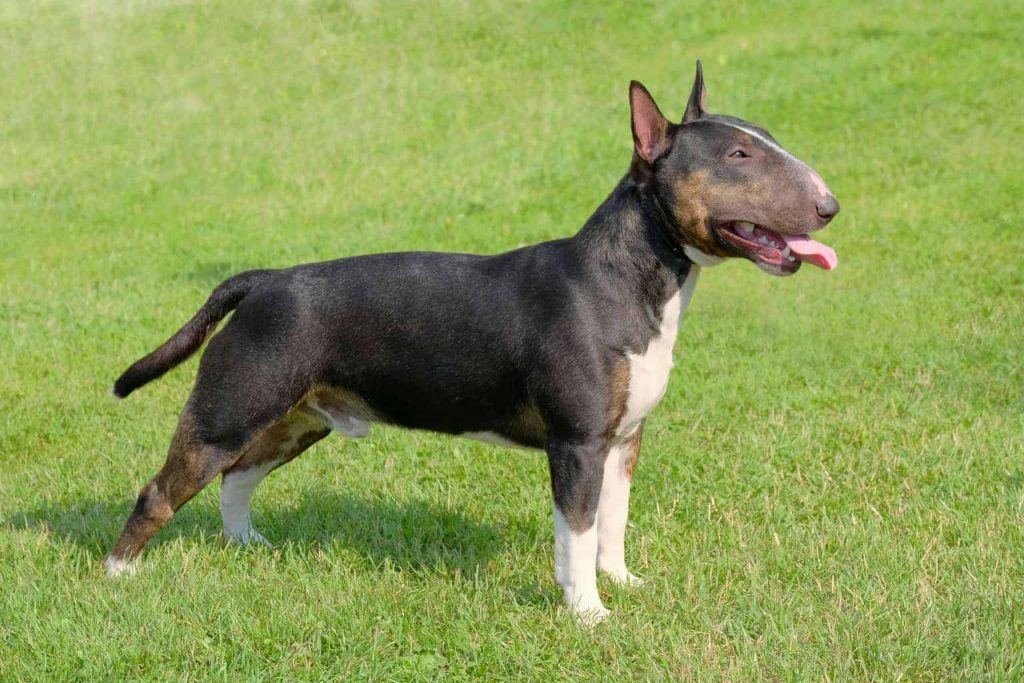
The bull terrier is classified as a guard dog. The FCI has classified him in group 3, the group of terriers. With a height of almost 50 centimeters, it has a weight of 26 to 30 kilograms. This dog is very imposing, which is only underlined by his strongly stocky physique. Without his so-called “downface” or the concise “egg head, he would not be so clearly recognizable.
The Bull Terrier has a short coat. He traditionally wears the colors black, white or brindle. He can reach the proud age of 12 years.
Despite its classification as a family dog, the bull terrier has appeared on the list in various states. He is affectionate, alert and loyal. His agility has made many an owner fit, as long walks or regular exercise or training at the dog park are his favorite. For a problem-free coexistence with his people and the neighborhood, consistent education is an absolute must. In the hands of beginners or with inconsistent owners he has lost nothing.
The Doberman
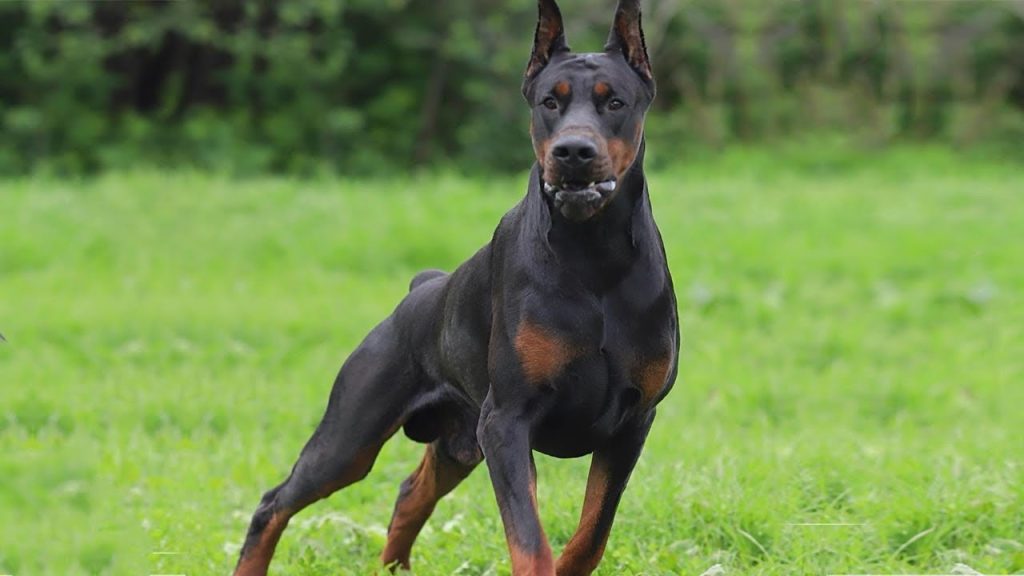
The Doberman is a short-haired, large guard dog, classified by the FCI in group 2. He wears the colors brown and black. Certainly he is devoted to his owner and very affectionate. If you think you can keep your couch to yourself, you are wrong. However, one must not be deceived by the fact that he can be very suspicious.
In addition, he is still very brave and extremely agile. As a couch potato he is absolutely not suitable. Besides long walks or hikes, he is particularly suitable for training as a guard or protection dog. This is possible in the private sector as well as with the police or customs.
Of course, guard dogs like the Doberman can also assist guards of security companies in guarding commercial objects. However, he is not aggressive at all. This agility it is also the reason for a well-developed work and training program for the Doberman. The best way is a combination of different dog sports, so that physical and mental efforts are on the schedule.
The dog, which can grow up to 70 centimeters tall and weigh 45 kilograms, has a life expectancy of 10 to 13 years.
Caucasian Owtscharka
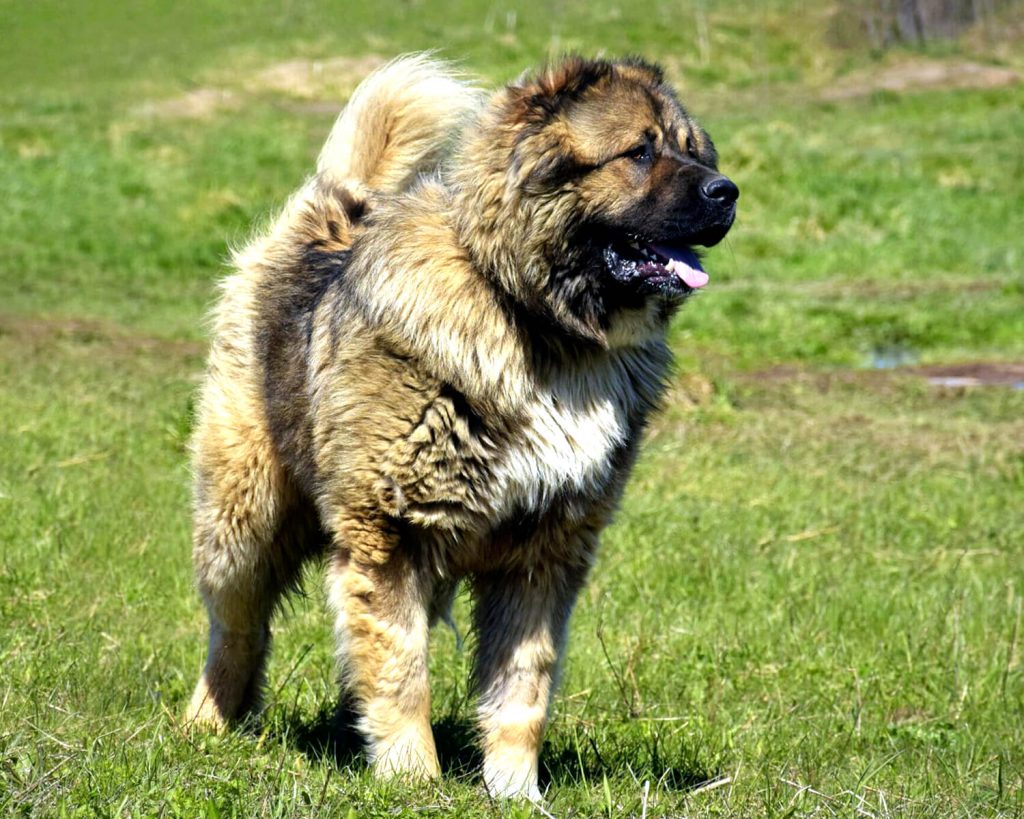
Its native country is Russia. It was assigned to the guard dogs, while the FCI placed it in group 2. Thus, it belongs to the large dog breeds. This is also reflected in its shoulder height of 65 centimeters.
The Ovcharka belongs to the original shepherd guard dogs, which were found in the Russian catchment area and still are. This makes them very independent animals that know what to do at every moment. Thus, a certain aggressiveness is attributed to them, but it is actually more evident in their original task. They find their origin well before 10,000 years with the primitive dogs.
As a family and companion dog they are therefore only conditionally capable. For this, his understanding of his task as a protection and guard dog is much too great. As calm and even-tempered as he is, he is suspicious of anyone who does not belong to his family, to his herd. This is even the mailman who comes to the door every day.
Always remember, no matter how well you have trained the chewing rabbit: HE IS NATURALLY SHARP! And unfortunately, apart from other chewing rabbits, he is quite incompatible with other dogs. A good fence of 2.0 to 2.5 meters high is probably necessary everywhere. This is where people with real dog sense are needed.
The Mastiff
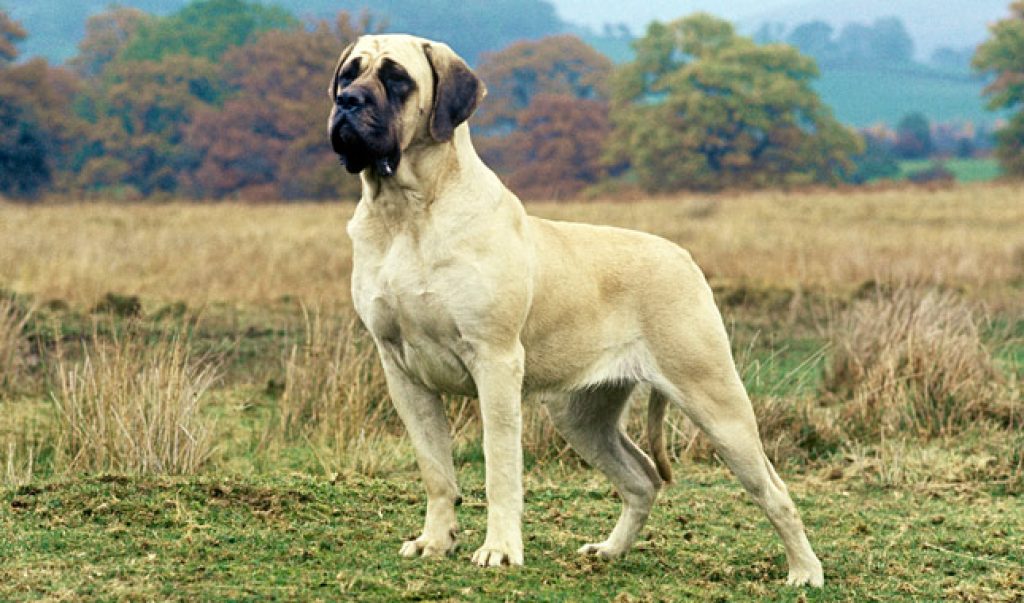
The Mastiff originates from Great Britain and can live from 7 to 9 years. Scarce 71 centimeters height at the withers and a maximum weight of 75 kilograms make him a huge mountain of strength. This one, however, is full of energy and drive. He probably has his roots in antiquity with the Babylonians.
In the last decades he was bred only as a companion dog, so that the formerly bred dangerousness decreased more and more, but the composure and ability to be controlled became stronger and stronger.
Yes, he is sometimes stubborn. Yes, undesirables can just be “put up against the wall”. But he would never bite. Despite his origins, he masters the temperament test as well as the companion dog test as if he never does anything else.
Dog sense, a calm mind and a good assertiveness are necessary for this dog. Due to the current breeding towards more and more size and therefore more weight, he is more prone to joint problems, heart and eye diseases. Also the rather short life expectancy is caused by gigantism.
The Rottweiler
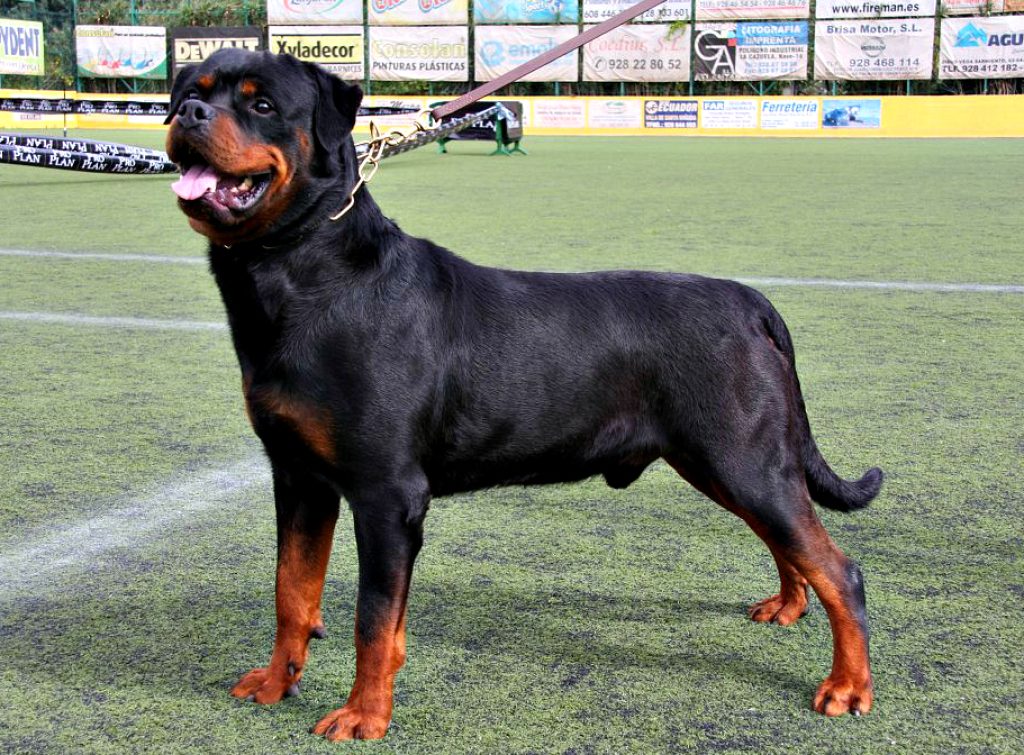
Classified by the FCI in group 2, the Rottweiler belongs to the dogs which find their field of activity among other things as police dogs. In addition, he can also be used as a guide dog, service dog, guard dog, family dog. He wears short, black fur with brown markings.
The Rottweiler requires a very good and solid basic training before being put into final training with special training. Because training is even more important for the Rottweiler than for other dog breeds. That he can be used in so many ways is due to his unique character. For he is not only obedient and self-confident. He is also very affectionate, good-natured, fond of children and friendly. With him it is important to work with the right signals to get the correct result.
The Rottweiler not only looks massive, he also knows how to use this mass in the best possible way. Hardly any attacker can counter this. The Rottweiler is not suitable for beginners. Because even if he is capable of learning and obedient, he should be looked after by experienced dog owners. In addition, an appropriate dog trainer should be consulted to work out the correct signals, the commands necessary for this dog.
For the beginner, these tasks would be too complex, so that the dog would feel called to take command. To children, on the contrary, usually exceptionally friendly and lets them. Unfortunately, problems with hips, elbows, joints and heart have arisen during the breeding years.
Staffordshire Bull Terrier
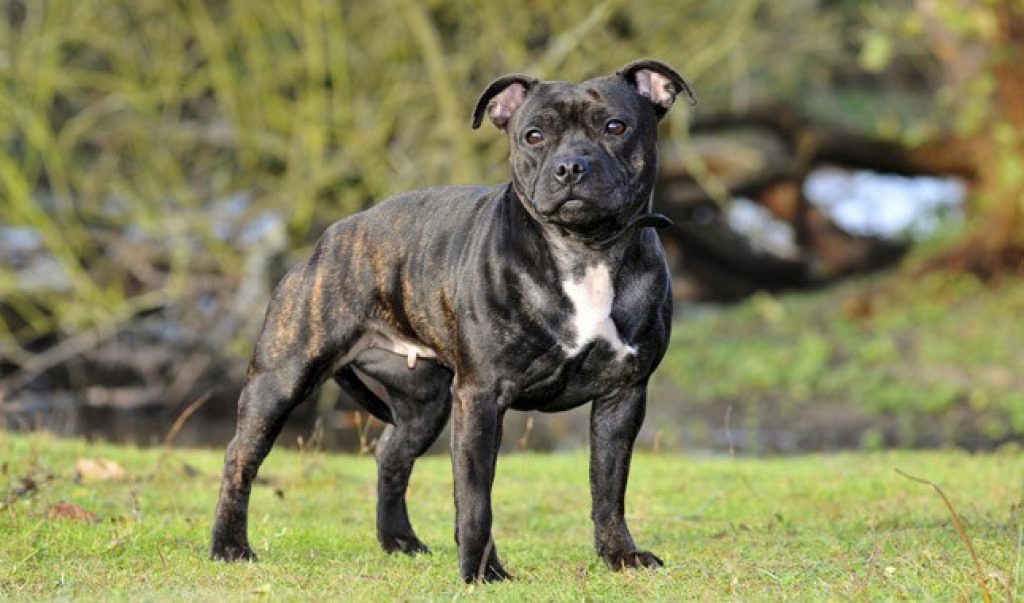
The Staffordshire Bull Terrier is also called “Nanny Dog” in his country of origin. Strange that in UK he has nevertheless ended up widely on the fighting dog list. Because actually he is extremely fond of children, so he is a popular family dog in England. This dog breed was created by crossing different types of terriers. He belongs to the medium-sized dogs and has a stocky-bulky figure. Its characteristic is the high set ears. They give it a funny appearance as they quickly tilt forward.
He reaches a shoulder height of 40.5 centimeters and a weight of 17 kilograms. His coat is short, smooth, and in most cases, solid in color. Black, white, fawn, red, blue, but on brindle coloring can occur.
As good-natured as the Staffordshire Bull Terrier is, he can also be dominant and high-handed. Therefore, not only a consistent, but even a strict and yet loving education and attitude of the animal is necessary. As long as he knows who the alpha animal is and this one also demands the respect, there should be no problems with the dog. This dog needs tasks and responsibility so that he fits in the family without any problems.
Conclusion
It is not the breed, but the upbringing and the ability to handle the dog correctly that turns a supposedly dangerous dog, into a “normal” dog. Theoretically, any dog can become dangerous if it goes through the wrong upbringing, the wrong attitude – even the smallest dogs.
Of course, this is also true for the big dogs and, of course, for those who have inherited a certain combativeness in their genetics. The better a puppy is socialized, the better it can be matched with other dogs. The more consistent (and at the same time affectionate) he experiences his training and also the daily togetherness with people, the easier it will be to live together, also for the people, and the more adapted this dog will be.
FAQ
Who decides which dog is put on the fighting dog list?
Unfortunately, there is no uniform fighting dog list in UK. It is the federal states that determine which dog is placed on the list in their catchment area. In principle, however, each local office, each municipality can also make a corresponding decision.
Where can I find out what regional requirements are imposed on owners of fighting dogs?
The responsible local office provides information about the requirements that are made. Since dogs are to be officially registered, one will automatically receive the corresponding leaflets.
What are the characteristics of a fighting dog?
According to historical tradition, these dog breeds have been bred for dog fighting or as war dogs. Thus, they show a tendency to aggression and tend to attack other dogs, animals and even people. At least that is the theoretical definition.
Are all dog breeds on the list actually dangerous and therefore to be avoided?
Not so. Because each dog is the product of its potential and its use / application. Thus, these dogs have a potential that has been passed on genetically for decades / centuries. If now the negative potential is left aside and not promoted during the education and socialization of the animal, there is a concentration on the positive potential of the dog with a corresponding positive reinforcement, then there is a very large chance that the negative potential will never show itself. However, since there is no guarantee of this, a certain amount of mindfulness must always be maintained.
Is it possible to breed all fighting dogs in UK?
Various dog breeds on the list are allowed to be bred here in UK. For others, various permits must be obtained from the relevant offices. Not an easy undertaking, but definitely possible.











